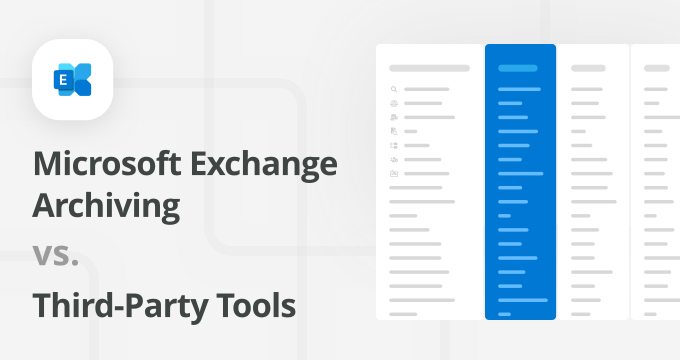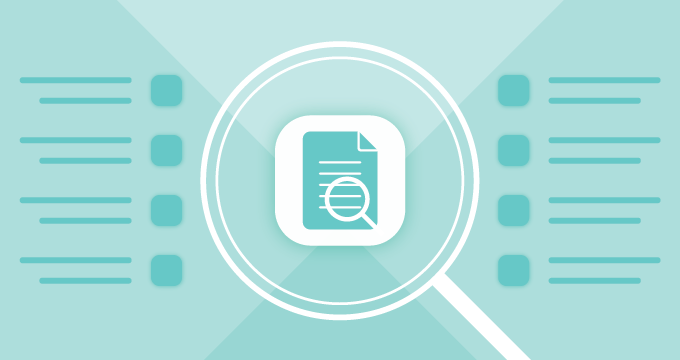Electronic discovery or ediscovery is one of those unavoidable tasks that everyone dreads. As a critical process in legal compliance, ediscovery requires companies to locate, collect, and preserve electronically stored information (ESI) for use in lawsuits, audits, and investigations.
But with massive volumes of data, complex regulations, tight deadlines, and staggering costs, it’s no wonder that many think ediscovery sucks and feels overwhelming.
Luckily, it doesn’t have to be this way if you have the right processes and tools in place.
In this blog post, we’ll discuss:
- The ins and outs of the ediscovery process
- How to prepare for and handle an ediscovery request
- How data archiving can help you streamline ediscovery, minimize risks, and cut costs
What Is Ediscovery and Why It’s So Important?
Electronic discovery is a process in which electronically stored information (ESI) is captured, collected, and preserved to be used as evidence in a lawsuit, audit, or investigation.
The term can also be used when data is retrieved for regulatory compliance, HR inquiries, proof of client communications, and other similar corporate needs. Ediscovery is a vital part of legal compliance when legal proceedings or regulatory bodies demand that parties in a dispute provide data as evidence in court.
Despite its importance, ediscovery is often seen as a dreaded task for organizations due to its complexity, high costs, and time-consuming nature. This guide aims to help you navigate the challenges of ediscovery and provide practical steps to prepare your organization.
Why Ediscovery Sucks?
The main reason why ediscovery sucks lies in the fact that it’s not your regular search-and-retrieve task but a multifaceted process fraught with legal, technical, and organizational challenges.
Here are the main factors that make ediscovery feel like an uphill battle:
- Vast amounts of data. ESI now accounts for 90% of all information collected for legal discovery, including emails, text messages, instant messages, social media posts, and data on personal devices. Adding video conferencing tools into the mix only increases the complexity, as organizations must manage unstructured data scattered across various platforms. This makes data collection a monumental and resource-intensive task.
- Diverse data sources. As mentioned, data resides in multiple formats and locations — on servers, backup tapes, cloud storage, and personal devices. Tracking down relevant data scattered across various platforms can be incredibly daunting.
- High costs. The cost of ediscovery is staggering. On average, organizations spend over $1 million annually on ediscovery, with some Fortune 1000 companies shelling out up to $30 million annually. This expense is mainly due to the need for legal experts to review data, which constitutes about 80% of the total cost.
- Strict deadlines. Courts often impose tight deadlines for producing data, sometimes requiring organizations to respond within days. This urgency forces companies to allocate extensive resources, often at the expense of their daily operations.
- Legal and compliance risks. Failing to produce the required data or mishandling it can lead to severe penalties, including fines and adverse legal judgments. For smaller companies, these repercussions can be catastrophic.
The Six Stages of Ediscovery
The Electronic Discovery Reference Model (EDRM) is a conceptual representation of the stages in the ediscovery process. It’s important to note that organizations can diverge slightly from this model in that they may “engage in some but not all of the steps outlined in the diagram or carry out the steps in a different order.”
Electronic discovery is often viewed as a part of a larger framework called information governance (IG) — a holistic approach to managing corporate information that includes people, technology and processes that ensure that corporate information is created, handled, treated and disposed of properly.
IG is important because it helps to mitigate risk and expenses in case ediscovery becomes an issue.
The ediscovery process typically consists of the following stages:
- Identification — The organization locates relevant sources of electronically stored information and determines what information is relevant to the case.
- Preservation — The organization makes sure that the relevant ESI is tamper-proof and protected against deliberate alteration and destruction.
- Collection — Relevant data is gathered to be used in the ediscovery process. This stage is critical as unstructured data often resides on servers, can be scattered across the organization — in places like email, instant messages or on employees’ personal devices.
- Processing and review — If necessary, the collected data is converted to forms more suitable for analysis (PDF, TIFF images etc.) and is subsequently reviewed for relevance.
- Production — Electronically stored information is delivered to parties in dispute using appropriate mechanisms.
- Presentation — The collected information is presented before an audience (e.g., a trial).
Will It Happen to My Organization?
There are different situations in which you might be faced with an ediscovery request. For example, a regulator for your industry may ask your organization to produce some information as part of a compliance request.
Similarly, in the business landscape, litigation is not a matter of if but when.
According to a recent Norton Rose Fulbright survey, 61% of organizations in the U.S. were involved in at least one regulatory proceeding in 2023, compared to 50% in 2022. Forensic data is especially important and may be requested when there is an allegation of fraud or sexual harassment.
How to Prepare for Ediscovery: Four Crucial Steps
Fully prepared organizations are able to cope with an ediscovery request in only one-third of the time that unprepared businesses take to respond. Here are the four essential steps to take while preparing.
1. Establish ediscovery best practices: What? Who? Where?
What?
The type of electronic information you store will depend on your industry and business processes, but make sure you make a data map.
Drafting a map of all the communication channels and storage systems you use will help manage all relevant information. You should start with cloud storage and employee laptops, but include mobile devices and company’s social media accounts as well.
Electronic data is different from traditional, paper evidence, not only because of its intangible form and transience but also because it’s accompanied by metadata (e.g. the device used to send a message or the date and time an email was written) that can play a vital part as evidence and also needs to be preserved.
Therefore, to preserve document metadata and to make electronic corporate exchanges searchable, it’s not enough to print an email or take a screenshot, especially because such formats can be susceptible to evidence spoliation.
Who?
Identifying custodians is the next logical step.
After some years of little to no involvement with ediscovery, IT departments are now becoming responsible for data management in many organizations. This is because digital data is growing so fast, and IT staff tend to be best equipped to deal with it.
Understandably, IT teams are hesitant to take on the combined burden of data storage and compliance, which can feel overwhelming and chaotic.
Where?
After you’ve identified the key players in the case and know what kind of electronic information you’re looking for, you need to focus on the “where” question. Knowing the exact location of your data will minimize ediscovery expenses and delays once discovery is under way.
Centralizing data management through archiving solutions can streamline this process. As email is the most common form of data produced by organizations, implementing an automated solution that can retain all enterprise email is a good first step.
2. Adopt data retention and file destruction policies
The first rule is to have a data retention policy in place.
One of the key recommendations is for companies to get a grip on their information retention plans.
You need to outline a clear retention policy so that your organization can expunge unnecessary data with confidence. The decision to let your employees decide which emails to save and which to purge will probably come back to haunt you when auditors, lawyers, or compliance authorities knock at your door.
Another crucial factor to consider is including all forms of communication.
Although 75% of the information contained in email is considered critical to business operations, not all electronic content today is email. Organizations need to understand that the information that flows through alternative channels like social media, text messages, video conferencing tools, and instant messengers is equally important.
It’s also important to highlight the potential legal ramifications of using corporate communication systems for personal matters.
Check how your employees are using personal and enterprise-issued phones, include mobile communications in your policy, and ensure that it spells out both company expectations of employees and the potential legal ramifications of any electronic communications (email, WhatsApp, social media interactions, etc.) initiated from the workplace.
The policy must clearly specify that no electronic communication initiated from a workplace technology platform (and this can even extend to company-issued smartphones) is considered privileged or private. It must be clear to all employees that all written electronic communication is considered discoverable.
There have been cases in which divorce attorneys have subpoenaed personal emails sent by an employee through a corporate email system.
3. Create synergy between IT and legal departments
The two teams that often seem at odds with each other will have to collaborate in order for your organization to have a successful ediscovery program.
Each team possesses very specific knowledge and a close cooperation between them is critical for successful ediscovery. Your legal team needs to understand the technical aspect of record preservation, while your IT department can’t know much about the organization’s legal obligations unless they join forces with legal.
4. Invest in ediscovery technology
There’s no better way to control your enterprise information, observe all federal, state and industry regulations (including data privacy laws), ensure ediscovery readiness and provide relief to your IT and compliance departments than to invest into proper technology.
The discovery process once relied primarily on lawyers sifting through documents and looking for evidence. This manual process has been replaced by various types of software that use complex algorithms to search and produce relevant documents.
The main advantage of ediscovery tools lies in the fact that they can sift through a vast amount of data quickly and find specific documents relevant to a legal request. Storage administrators have a number of options for managing discovery requests for email and other electronic records, and archiving is one of them.
How Data Archiving Fits Your Litigation Response Strategy
Data archiving is hardly a new practice, and it has always been known to improve ediscovery preparedness.
A robust data archiving solution is essential for simplifying ediscovery and enhancing your organization’s litigation response strategy. Here’s how key features like advanced search, legal hold, audit trails, redaction, and export functionalities help streamline the ediscovery process:
1.Advanced search
Effective ediscovery depends on finding the right data quickly.
A powerful archiving solution should offer advanced search capabilities, including Boolean search, wildcard and proximity operators, fuzzy searches, and keyword search options.
These features allow you to search through email content, subject lines, senders, and recipients to locate relevant information accurately. Jatheon’s advanced search combines these tools, ensuring you retrieve data with pinpoint accuracy.
2.Legal hold
One of the email archiving features crucial for ediscovery is a legal hold, a process organizations use to preserve all relevant information as soon as litigation is anticipated.
It involves the prevention of processes such as document deletion and alteration of retention policies. In simplest terms, a legal hold suspends the regular retention schedule.
When there is reasonable anticipation of litigation, data identified as potentially relevant to the case is placed under legal hold.
The person in charge of issuing a legal hold needs to identify the relevant electronic information, clearly inform employees that these documents must be preserved and protected from destruction or alteration, and make sure that legal hold stays in effect until the completion of the lawsuit.
This ensures that critical information is retained and protected from tampering during legal proceedings.
3.Audit trail
Proving the integrity of your data is crucial in any legal case. Audit trail features in archiving solutions log user activity, including searches, data access attempts, and any changes, ensuring that evidence hasn’t been tampered with.
This adds an extra layer of security and helps maintain a clear chain of custody.
Email archiving solutions enable admins and compliance officers to perform audits.
The audit trail feature is essential for maintaining transparency and accountability in your data management practices, especially during litigation.
For instance, if an employee attempts to access a section they are not authorized to access, this activity will be recorded in the audit trail. This feature helps organizations to prove that the records have remained unchanged.
4.Redaction
Compliance with data privacy laws is critical, especially when handling sensitive information.
The redaction feature allows you to conceal personally identifiable information (PII) directly within the archiving software, protecting data such as SSNs, credit card numbers, and medical history.
Jatheon’s integrated redaction tools reduce response times to ediscovery requests while keeping your data secure.
5.Export
Once data is identified and reviewed, it must be exported securely for legal use.
A reliable archiving solution should handle large volumes of data and support various export formats, such as PST, EML, and PDF, allowing you to deliver evidence efficiently.
6. Automated data retention
Every email, just like any other kind of electronically stored information, is subject to document retention regulations and destruction policies. Old emails should be deleted, but only when they reach the end of the standard retention period.
Automating your data retention process is crucial for ensuring compliance and simplifying ediscovery. With Jatheon’s advanced archiving solution, you can set custom retention policies that automatically apply to every new piece of archived data, including emails, social media, and mobile communications.
Jatheon’s automated system ensures that data is retained according to your organization’s policies and securely deleted when the retention period ends, reducing manual oversight and errors.
Handle ediscovery requests with zero stress. Search, redact, export, and review using Jatheon Cloud data archiving software.
Summary of the Main Points
- Ediscovery involves locating, collecting, and preserving electronically stored information (ESI) for legal, compliance, or investigative purposes. It’s a critical but complex and often costly process required in various legal and regulatory scenarios.
- The process is complicated by vast amounts of data, diverse data sources, high costs, tight deadlines, and significant legal risks. These factors make ediscovery feel overwhelming for many organizations.
- Identification, Preservation, Collection, Processing and Review, Production, and Presentation form the core steps in the ediscovery process, each with its own set of challenges and requirements.
- Most organizations will face ediscovery requests due to litigation or regulatory compliance, making it crucial to be prepared..
- Preparation for ediscovery includes establishing best practices by mapping data sources, defining retention and destruction policies, fostering collaboration between IT and legal teams, and investing in ediscovery technology to automate processes and ensure compliance.
- Data srchiving solutions enhance ediscovery readiness by indexing, preserving, improving searchability, and automating the retention of electronic communications across all platforms.
FAQ
Who’s responsible for ediscovery?
Responsibility for ediscovery typically falls on both the IT and legal teams. IT handles data management and preservation, while the legal team ensures compliance with legal requirements. Collaboration between these departments is essential for a successful ediscovery process.
What are the biggest ediscovery risks?
The biggest risks in ediscovery include data loss or alteration, which can result in severe legal penalties, and high costs associated with manual data review and legal fees. Non-compliance with deadlines, data breaches, and over-retention of unnecessary data further complicate the process, leading to financial and reputational damage.
What is discoverable electronic information?
Discoverable electronic information includes data that can be used as evidence in legal proceedings. Apart from emails, this may include PDFs, Microsoft Word documents, spreadsheets, instant messages, social media posts, text messages, phone records, voicemails, metadata, audio/video files, and even data from wearable technology.
Read Next:Effective Email Retention Policy Best Practices for Staying Compliant Digital Evidence Examples — Insights from Recent Legal Cases |











